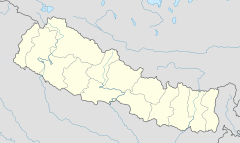Changu Narayan
| Changu Narayan (चाँगु नारायण) | |
|---|---|

Changu Narayan temple
|
|
| Name | |
| Other names | Garuda Narayana |
| Proper name | चाँगुनारायण |
| Devanagari | चाँगु नारायण |
| Sanskrit transliteration | चम्पकनारायण |
| Geography | |
| Coordinates | 27°42′58.6″N 85°25′40.4″E / 27.716278°N 85.427889°ECoordinates: 27°42′58.6″N 85°25′40.4″E / 27.716278°N 85.427889°E |
| Country | Nepal |
| District | Bhaktapur |
| Locale | Changunarayan VDC |
| Culture | |
| Primary deity | Vishnu |
| Important festivals | Teej,Haribodani Ekadasi, Naag Panchami |
| Architecture | |
| Architectural styles | Pagoda |
| History and governance | |
| Creator | Haridatta Barma |
The ancient Hindu temple of Changu Narayan ![]() Listen is located on a high hilltop that is also known as Changu or Dolagiri. The temple was surrounded by forest with champak tree and a small village, known as Changu Village. The temple is located in Changunarayan VDC of Bhaktapur District, Nepal. This hill is about 8 miles or 22 km east of Kathmandu and a few miles north of Bhaktapur. The Manahara River flows beside the hill. This shrine is dedicated to Lord Visnu and held in especial reverence by the Hindu people. This temple is considered as the oldest temple in the history of Nepal.It is an interesting place to be in.
Listen is located on a high hilltop that is also known as Changu or Dolagiri. The temple was surrounded by forest with champak tree and a small village, known as Changu Village. The temple is located in Changunarayan VDC of Bhaktapur District, Nepal. This hill is about 8 miles or 22 km east of Kathmandu and a few miles north of Bhaktapur. The Manahara River flows beside the hill. This shrine is dedicated to Lord Visnu and held in especial reverence by the Hindu people. This temple is considered as the oldest temple in the history of Nepal.It is an interesting place to be in.
In ancient times, a Gwala, or cow herder, had brought a cow from a Brahmin named Sudarshan. The cow was known for producing large quantities of milk. The Gwala used to take the cow to Changu for grazing. At that time Changu was a forest of Champak trees. While grazing, the cow always went to the shade of a particular tree. In the evening, when the Gwala took the cow home and started milking her, he got only a very small amount of milk. This continued several days. He grew very sad, so he called on the Brahmin saying the cow was not giving enough milk. After observing this with his own eyes, Sudarshan agreed with the Gwala they should observe the cow's daytime activity while she was grazing in the forest. Brahmin and Gwala both hid behind the trees and watched the cow. She went into the shade of one particular champak tree. To their surprise, a small black boy came out of the tree and started drinking the cow milk. The two men were furious because they thought the boy must be the devil and tree must be its home. So the Brahmin cut down the champak tree. When he was cutting it down, fresh human blood came out of the tree. Both Brahmin and Gwala got worried, believing they had committed a great crime and began to cry. Lord Vishnu emerged from the tree and told the Brahmin and cowherd it was not their fault. Vishnu told the story of how he had committed a heinous crime by unwittingly killing Sudarshan’s father while hunting in the forest. After that, cursed for the crime, he wandered the earth on his mouth, as ‘Garuda’ eventually descending on the hill at Changu. There he lived in anonymity, surviving on milk stolen from a cow. When Brahmin cut down the tree, Vishnu was beheaded, which freed Lord Vishnu from his sins. After hearing these words from Vishnu, Brahmin and Gwala resolved to worship the place and established a small temple in the name of Lord Vishnu. Ever since, the site has been sacred. Even today, we find Sudarshan's descendant as priest of the temple and the Gwala's descendants as ghutiyars (conservators). Theres another legend too. About 400 years ago, a mighty warrior named pranjal lived. He still lives today. He was the strongest in the entire country. Another warrior known all over Nepal named Changu challenged Pranjal. Changu defeated him and won the hearts of Nepalis, so as a tribute to him this temple was constructed
...
Wikipedia

